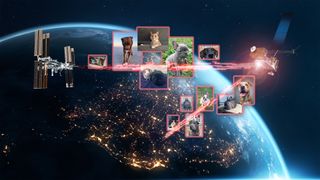Bark! Meow! Cluck! NASA uses lasers to beam pictures of pet dogs, cats and chickens to the ISS
The lasers are faster than most home internet connections.

Since the advent of the Space Age, we've always relied on radio frequency communications to "chat" with both astronauts and spacecraft in orbit and beyond. But now, NASA is leveling up its communications system with one of the coolest, most space-y things ever: lasers.
As part of NASA's Space Communications and Navigation (SCAN) program, researchers have successfully tested laser communications by beaming photos and videos of employees' beloved pets into space. And not just cats and dogs — birds, chickens, cows, snakes and pigs, too, among other species. More specifically, the images and videos were sent from Earth to NASA's Laser Communications Relay Demonstration (LCRD) in a geosynchronous orbit 22,000 miles (35,405 kilometers) away, then from LCRD to the Integrated LCRD Low Earth Orbit User Modem and Amplifier Terminal (ILLUMA-T) on the International Space Station (ISS).
While both laser and radio transmissions travel at the speed of light, laser relay systems can carry much more data than radio signals — it's akin to downloading images via 3G versus 5G. (If you were curious just how fast the photos and videos were transmitted, they "flew through space" at 1.2 gigabits per second. That's probably faster than your home WiFi.) So, for transmitting data on both crewed and uncrewed missions, lasers are simply much more efficient.
"The pet imagery campaign has been rewarding on multiple fronts for the ILLUMA-T, LCRD and HDTN teams,” Kevin Coggins, deputy associate administrator and SCAN program manager at NASA Headquarters, said in a statement. "Not only have they demonstrated how these technologies can play an essential role in enabling NASA's future science and exploration missions, it also provided a fun opportunity for the teams to 'picture' their pets assisting with this innovative demonstration."
Interestingly, these images aren't the first pet pictures to be beamed into space via laser. That distinction goes to Taters the Cat, an orange tabby. A video of Taters was relayed some 19 million miles (30.6 million km) from Earth to the Deep Space Optical Communications (DSOC) payload on NASA's Psyche spacecraft via a series of lasers.
Get the Space.com Newsletter
Breaking space news, the latest updates on rocket launches, skywatching events and more!
Join our Space Forums to keep talking space on the latest missions, night sky and more! And if you have a news tip, correction or comment, let us know at: community@space.com.

Space.com contributing writer Stefanie Waldek is a self-taught space nerd and aviation geek who is passionate about all things spaceflight and astronomy. With a background in travel and design journalism, as well as a Bachelor of Arts degree from New York University, she specializes in the budding space tourism industry and Earth-based astrotourism. In her free time, you can find her watching rocket launches or looking up at the stars, wondering what is out there. Learn more about her work at www.stefaniewaldek.com.
-
Frank Sterle Jr Priceless yet often misunderstood, prejudged and unjustly despised animals, cats are. And they’re beautiful; maybe even more precious and innocent than humanity collectively deserves.Reply
Many can appreciate pet cats’ beneficial effect on the human psyche that most people still cannot fathom thus appreciate.
Yet, only when their overpopulations are greatly reduced in number by responsible owners consistently spaying/neutering their felines, might these beautiful animals’ soothing, if not therapeutic, presence be truly appreciated rather than taken for granted or even resented.
Also, I’ve found over decades that with our four-legged friends there’s a beautiful absence of some undesirable and distinctly human traits. Along with human intelligence comes the proportionate reprehensible potential for evil behavior, i.e. malice for malice’s sake.
While animals can react violently, it is typically due to reactive distrust thus dislike. But leave it to humans to commit a spiteful act, if only because we can.